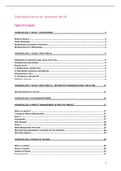College aantekeningen
Samenvatting Alle Hoorcolleges OTD (organisatietheorie en dynamiek)
- Vak
- Instelling
- Boek
Een overzicht van alle hoorcolleges in pdf vorm met inhoudsopgave zodat je ook makkelijk kan zoeken daarmee. Ook kun je makkelijk zoeken door control F te gebruiken!!
[Meer zien]













